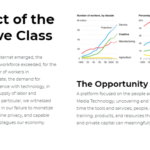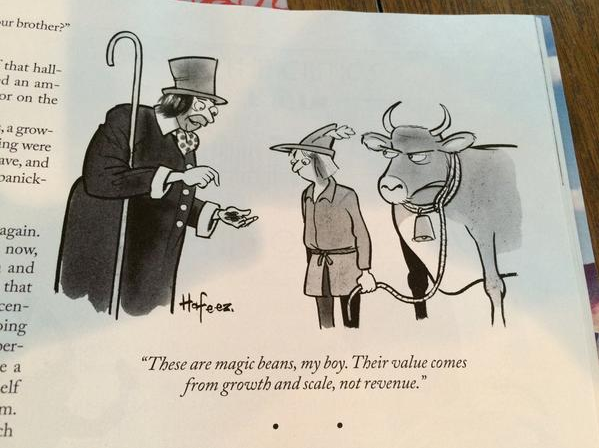Okay so perhaps implying that you might be a moron is a bit harsh but let’s be realistic, as a startup in need of funding, if you fail to secure that funding simply because you haven’t done your homework or your failure to communicate effectively, you’re a moron.
I’ve explored in the past, quite a bit about what it takes to effectively position and communicate what you do. When raising capital, what and how you communicate is arguably more important than your validation and traction. How you communicate your own business, is a reflection of who you are and I’d hazard a guess that you aren’t a moron; while you could possibly pitch your startup more effectively, your pitch and how you communicate it is quintessentially you. So what part of a startup pitch might make you look like a moron? How you position and communicate what “they” do.
Invariably, your competitors slide is abysmal
Looking something like what I have here to the right, what makes you look like a moron is suggesting that you do everything while your competitors fall short.
“We have all the features and benefits that the market wants, filling the gaps our competitors have overlooked.”
Even worse is when founders suggest a price point that’s lower than everyone else: “We’re better, more developed, and less expensive!”
While you may believe it, it’s very unlikely true; more importantly, you are subconsciously communicating a few things that will torpedo your burgeoning investor relationship.
How Competitors Slides Kill Conversations
Consider three messages conveyed in such a slide and be certain that you’re conveying what you want construed.
1. Yes, we actually do everything! And our competitors (those morons) are overlooking something obvious.
Really? That doesn’t even pass the sniff test. Forget whether or not it may even be true, you’re suggesting to potential investors that your competitors are just blind to opportunity that you discovered? That they haven’t invested in and tried many of those things. You’re also conveying to an extent, that you don’t need their investment – “we already do everything.” A common reply from investors in such circumstances? “Great, let us know how it goes and we’d like to take another look when you have more customers.”
You really do everything? At a lower cost?
2. Okay, truth be told, we haven’t done any in depth research and we’re just giving you the cursory us vs. them slide
In offering no sophistication in how you position the competition, you suggest that you haven’t really looked into what they do and are merely marking the haves and have nots. Why do I say that? Since we abandoned software for the internet, we’ve evolved into an economy of iteration. Products are never done. Services are never fully baked. Everything is in development.
Just as you want to avoid accidentally communicating that you don’t need money because you already do everything, it can’t be true that your competitors simply have or do not have various features. You each are working along a spectrum toward the delivery of various benefits and a sophisticated founder (who has done the marketing to know their competitive landscape) would understand where along that spectrum one’s competitors fall – while understanding that there is also value in communicating that your own startup is also along that spectrum to varying degrees.
3. We haven’t planned strategically about where to prioritize and invest our resources
See the challenge conveyed in our last point? If your market is so black and white as have and have not, you fail to convey that you are making strategic, planned, and intentional investments to develop the product the market actually wants. The market rarely wants everything. What are the features that you’ve deemed irrelevant, too costly at this stage, or deprecated?
Instead of saying that you’ve unwisely decided to invest your precious time and resources in everything, point out what you’re avoiding and foster a discussion of why you don’t want to waste your time there. Explore your competitors’ gaps to the same extent, and communicate why Competitor A can’t acquire customers as efficiently (yet) while Competitor B has invested in infrastructure and features they must now maintain. You have an edge because you don’t do everything and because you are deliberate about how and where to spend your time.
Doreen Bloch, CEO of Poshly, puts it well in a great review of the 8 things you should never include in a pitch deck that StartupCollective’s Scott Gerber pulled together, “An in-depth competitive analysis shows that the startup team understands the market and the competitive advantages that will be required to win in the industry.” I’ve bolded some of the text to draw your attention to my perspective on her point.
 Upfront Ventures’ Mark Suster suggests using the two-by-two matrix or Harvey Balls which establish your relative position and helps distinguish you from competitors, rather than erroneously positioning you as simply better. He adds for consideration, “I hate when I hear companies say [we have no real competition]. In some rare circumstances it is conceivable that this is true but it is very seldom.”
Upfront Ventures’ Mark Suster suggests using the two-by-two matrix or Harvey Balls which establish your relative position and helps distinguish you from competitors, rather than erroneously positioning you as simply better. He adds for consideration, “I hate when I hear companies say [we have no real competition]. In some rare circumstances it is conceivable that this is true but it is very seldom.”
Harvey Balls isn’t just a great name, it’s the sliced pie that you occasionally see in place of check marks: we’re half way done with this feature, fully finished here, just getting started with that one, and ignoring this entirely. You set the stage for a discussion of your investments – that which you’ve already made – and why you’re seeking additional investment. I think this approach is a little easier to develop than the matrix, which feels more subjective; either way, with this more sophisticated view of your competitors, you’ve moved the conversation from potentially looking like a moron to communicating your sophistication, insight, and opportunity.
Regardless of the approach you take, avoid the haves vs. have nots and shield yourself from the inevitable call on your bluff.




Finished up my latest deck and was pretty happy with what it looked like until I came across this article from Paul O’Brien.
My competition slide looked almost exactly like this lol. Back to the drawing board, two-by-two matrix it is!
I also dislike this slide! When I was told to do it by someone I was like “really? doesn’t everyone know this is bullshit?” I wasn’t familiar with Harvey Balls though. Thanks for posting!
Thanks for sharing Farhaj Mayan. This is one of my most popular articles and one I talk about constantly… I need some way to wrap up all the different perspectives into one To Do list for entrepreneurs! LOL
That would be awesome!
I keep a check list and harvey balls slide in my additional slides section for the random judge / investor that wants it. I just flip over to it and talk super briefly about it. It’s a slide that inspires love and hate, very little like.
ooh I like. That would definitely be a great thing to add to the appendix
Just did the Harvey Balls mockup and I do dig how it shows where we focus as compared to our competitors, while also giving them credit for what they’re good at.
Great article my friend!
And if you are a start-up and need competitive intelligence that will pass the sniff test – reach out. We do that. We will profile your company and your top 4 competitors ranking all on 20 factors to measure how much of a threat they pose. We call it CONQUER™ – It’s color coded to show you exactly where your competition is weak and how you can exploit their weaknesses and show investors you know the market. And it only takes 5 days.
HAHA yes. What are your fave alternatives??
Harvey Balls got my attention thanks to Mark Suster
Two by Two matrix is another good way
But I’ve been teaching what Steve Blank’s explored years ago, to startups, and I’m starting to think it’s best.
https://steveblank.com/2013/11/08/a-new-way-to-look-at-competitors/
Oooooh. I like this layout. Thanks for sharing!!
Harvey balls against (carefully chosen) reasons to win in the industry is a major win because it allows the verbal pitch delivered by founders to tell a story of positioning the startup in a market.
Even more relevant to VCs and AIs who have an investment thesis in that industry
A few more do the job as well – like TAM slide, pricing/business model. Some of these are breathtakingly stupid.
Pricing and business model I’m more forgiving about, it’s a startup and that’s not likely known. The screw up there is when it’s said with certainty, but there is none.
TAM slide is tough for everyone. In fact, probably a good video tutorial in that one.
? This is seriously so good, esp. the “economy of iteration” point. Furthermore, slides like this are often temporally dissonant: an apples-and-orange-tree-sapling comparison between competitors’ current deliverables vs. the startup’s still-unmanifested aspirations.
Mind blowing, how few incubators and mentors steer founders’ attention to the market; to the history of the sector, competitors
Becoming a primary talking point in my startup work with entrepreneurs
Coincidentally, I just wrote more about it on Quora
https://startups1.quora.com/Seek-competition-https-entrepreneurial-mindset-quora-com-Why-don-t-more-big-businesses-buy-out-their-competition-1
Or the classic quadrant leaders before they have paying customers
The learning never stops! Thank you for sharing
Thanks Justice, because this is a REALLY big one for founders. It’s disheartening to see a pitch deck with an awful competitive analysis.
You know how to GUARANTEE you won’t raise money? Neglect competition that will put you out of business